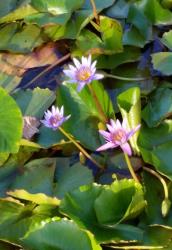Perennial (rarely annual) herbs, aquatic; rhizomatous with prominent petiole and peduncle scars. Many stout, fibrous, adventitious roots. Co-sexual. Stems and leaves with crystals. Leaves spiral, monomorphic or weakly dimorphic (strongly so in a few Nymphaea, not NZ); long petiolate; vernation involute; lamina floating or emergent, venation primarily palmate (Nymphaea) or pinnate (Nuphar); leaf bases cordate to sagittate; submerged leaves mostly similar to emergent. Peduncles, axillary or extra-axillary to an emergent leaf. Flowers, large and showy, bisexual, solitary, actinomorphic, with outer tetra-, tri- or pentamerous whorls of petaloid tepals; perianth parts free. Androecium with numerous stamens, whorled or spiralled (Nuphar?); pollination syndrome entomophilous. Gynoecium of 3–many carpels, partially to totally syncarpous, ascidiate or intermediate ascidiate/plicate (Barclaya), placentation laminar, post-genital carpel closure complete; stigmatic tissue, sessile, +/- flattened and radiate on an ovary disk (Nuphar) or stigmatic processes within a cup-shaped receptacle (Nymphaea); ovules many per carpel. Fruit berry-like.
The Nymphaeaceae is the most species-rich and diverse family of the Nymphaeales . Of the five genera (Barclaya, Euryale, Nymphaea, Nuphar, Victoria), two are represented in New Zealand (Nuphar and Nuphar) (Garnock-Jones 1988). Molecular phylogenetic and morphological analyses (Borsch et al. 2008; Löhne et al. 2007; Taylor 2008; Gruenstaeudl et al. 2017) have shown that Nymphaea is paraphyletic with respect to Euryale and Victoria. The position of Nuphar is unresolved as to whether it is an early diverging lineage of Nymphaeaceae or closer to Cabombaceae (Gruenstaeudl et al. 2017); the traditional classification within the Nymphaeaceae is retained here.
Species of this family have established from ornamental plantings in ponds and lakes and from inappropriately discarded plant material into waterways.
Macrophytes with floating leaves on long petioles and prominent, specialised air-canals in vegetative parts; crystals often obvious. Large, showy flowers which are apparently in whorls but appear more to be spiralled. The gynoecium is partially to totally syncarpic. Fruit berry-like.
About 70 aquatic species, almost cosmopolitan, temperate and tropical, exceptions include New Zealand and across the Pacific.
| Category | Number |
|---|---|
| Exotic: Fully Naturalised | 3 |
| Exotic: Casual | 1 |
| Total | 4 |




